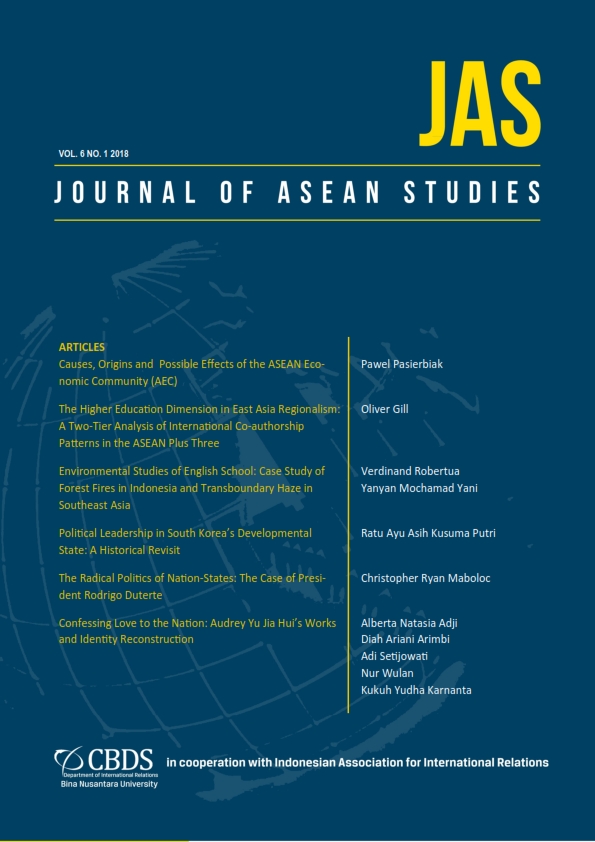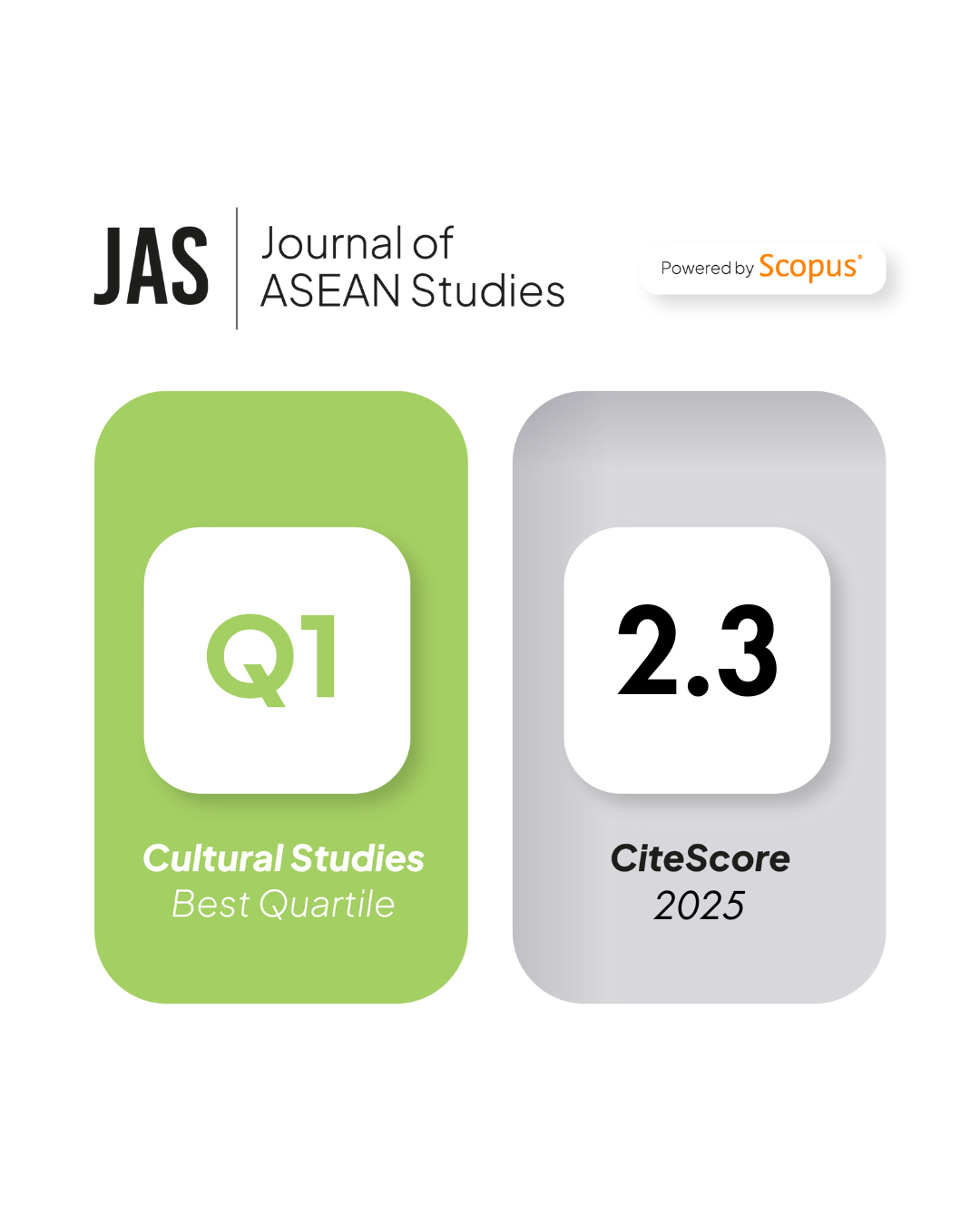Causes, Origins and Possible Effects of the ASEAN Economic Community (AEC)
DOI:
https://doi.org/10.21512/jas.v6i1.3897Keywords:
ASEAN Economic Community, regional economic integration, the European Union, Southeast AsiaAbstract
In 2007, the Association of Southeast Asian Nations (ASEAN) at its 13th summit decided to create the ASEAN Economic Community (AEC). In assumptions, the common market was to be established by the end of 2015, and the introduction of free movement of goods, services, capital and skilled labor was to lead to an increase in the degree of market integration among member states. But the creation of a single market is not an easy process, as illustrated by the case of the European Community/European Union, where a process of single market creation has been implemented slowly and with numerous difficulties. On the other hand, if the process of a common market creation is successful, the integration brings benefits to the participating countries. The primary goal of this article is to indicate potential effects as well as to show the progress of the implementation and functioning of the common market in the ASEAN Economic Community. To achieve the objective, the author will analyze the theoretical implications of a common market and the real implications, taking the European Union as an example. Having done this part of the analysis, the author will try to indicate and evaluate the possible effects of the process of the common market creation in the Association of Southeast Asian Nations.
References
ADB. (2008). Emerging Asian Regionalism. A Partnership for Shared Prosperity.
ASEAN. (2008). ASEAN Economic Community Blueprint. Jakarta.
ASEAN. (2012). Economic Community Scorecard. Jakarta.
ASEAN. (2014). ASEAN Annual Report 2013-2014. Jakarta.
ASEAN. (2015a). A Blueprint for Growth. The ASEAN Economic Community 2015: Progress and Key Achievements. Jakarta.
ASEAN. (2015b). ASEAN Annual Report 2014-2015. Jakarta.
ASEAN. (2015c). ASEAN Economic Community Blueprint 2025. Jakarta.
ASEAN. (2015d). ASEAN Integration Report 2015. Jakarta.
ASEAN. (2018). AEC Monitoring - ASEAN | One Vision One Identity One Community. Retrieved August 9, 2018, from http://asean.org/asean-economic-community/aec-monitoring/
Austria, M. S. (2012). Moving Towards an ASEAN Economic Community. East Asia, 29(2), 141–156. https://doi.org/10.1007/s12140-011-9169-5
Balassa, B. (1961). The Theory of Economic Integration. Greenwood Press.
Bhagwati, J. N., & Panagariya, A. (1996). The Theory of Preferential Trade Agreements: Historical Evolution and Current Trends. AEA Papers and Proceedings, 86(2), 82–87.
Bobowski, S. (2017). Internationalization of Micro, Small, and Medium Enterprises in ASEAN. In T. Löster & T. Pavelka (Eds.), 11th International Days of Statistics and Economics (pp. 143–152). Slaný: Melandrium.
Chia, S. Y. (2013). The ASEAN Economic Community: Progress, Challenges, and Prospects (ADBI Working Paper Series No. 440).
Eichengreen, B. (2008). The European Economy since 1945. Coordinated Capitalism and Beyond. Princeton: Princeton University Press.
European Commission. (1996). Economic Evaluation of the Internal Market. Brussels.
Hosny, A. S. (2013). Theories of Economic Integration: A Survey of the Economic and Political Literature. International Journal of Economy, Management and Social Sciences, 2(5), 133–155.
ILO-ADB. (2014). ASEAN Community 2015: Managing Integration for Better Jobs and Shared Prosperity. Bangkok.
Jetschke, A. (2012). ASEAN. In M. Beeson & R. Stubbs (Eds.), Routledge Handbook of Asian Regionalism (pp. 327–337). London and New York: Routledge.
Jones, L. (2016). Explaining the failure of the ASEAN economic community: the primacy of domestic political economy. Pacific Review, 29(5), 647–670. https://doi.org/10.1080/09512748.2015.1022593
Kamecki, Z. (1967). Pojęcie i typy integracji gospodarczej. Ekonomista, 1, 79–104.
Mazur, G. (2017). EU-ASEAN Free Trade Agreement(s) - Prospects and Challenges for Inter-Regional FTA. Research Papers of Wrocław University of Economics, (486), 141–156. https://doi.org/10.15611/pn.2017.486.12
Menon, J., & Melendez, A. C. (2015). Realizing an ASEAN Economic Community: Progress and Remaining Challenges (ADB Economics Working Paper Series No. 432).
Misala, J. (2005). Wymiana międzynarodowa i gospodarka światowa. Teoria i mechanizmy funkcjonowania. Warszawa: Oficyna Wydawnicza SGH.
Mucha-Leszko, B. (2012). Korzyści międzynarodowej integracji gospodarczej a osiągnięcia i problemy Unii Europejskiej. In W. Bieńkowski, S. I. Bukowski, & G. Olszewska (Eds.), Przyszłość integracji europejskiej – konkurencyjność i rynki (pp. 15–42). Warszawa: Wydawnictwo CeDeWu.
Plummer, M. G. (2006). The ASEAN Economic Community and the European Experience (ADB Working Paper Series on Regional Economic Integration No. 1).
Robson, P. (1998). The Economics of International Integration. London and New York: Routledge.
Sakane, K. (2018). ASEAN Integration: Opportunities and Challenges. In K. Konayashi, K. A. Rashid, M. Furuichi, & W. P. Anderson (Eds.), Economic Integration and Regional Development. The ASEAN Economic Community (pp. 11–33). Abingdon and New York: Routledge.
Soesastro, H. (2005). ASEAN Economic Community Concept, Costs, and Benefits. In D. Hew Wei-Yen (Ed.), Roadmap to an ASEAN Economic Community (pp. 13–30). Singapore: ISEAS Publishing.
Tinbergen, J. (1954). International Economic Integration. Brussels: Elsevier.
Watts, D. (2008). The European Union. Edinburgh: Edinburgh University Press.
Woetzel, J., Tonby, O., Thompson, F., Burtt, P., & Lee, G. Southeast Asia at the Crossroads: Three Paths to Prosperity (2014).
Yean, T. S., & Das, S. B. (2015). The ASEAN Economic Community and Conflicting Domestic Interests. An Overview. Journal of Southeast Asian Economies, 32(2), 189–201. https://doi.org/10.1355/ae32-2a






















